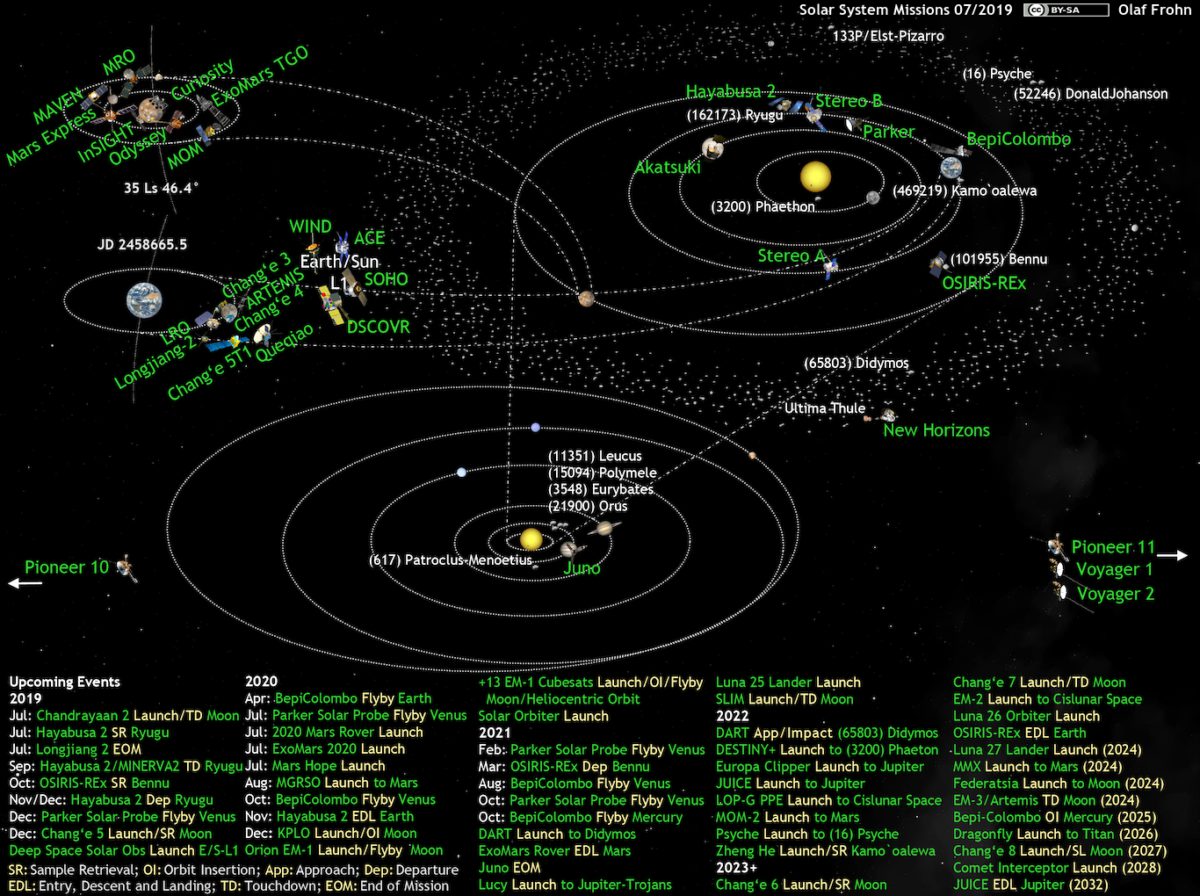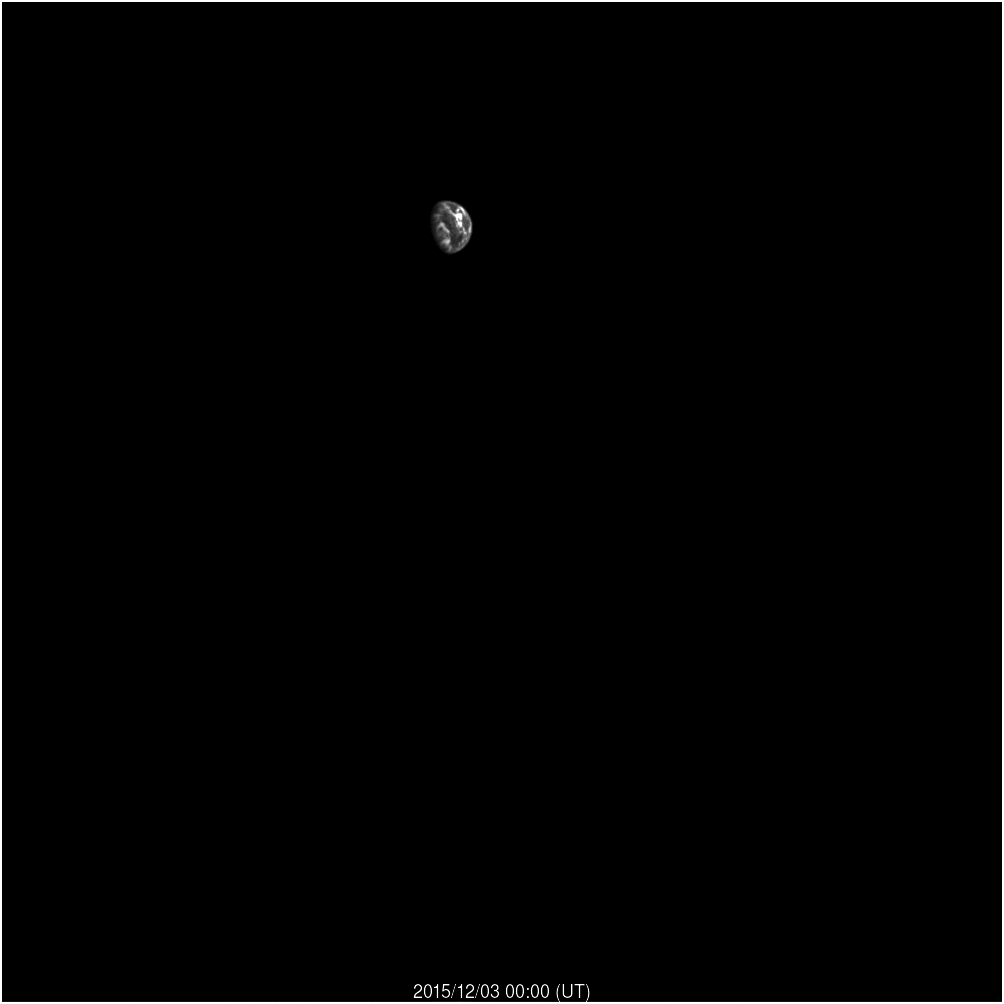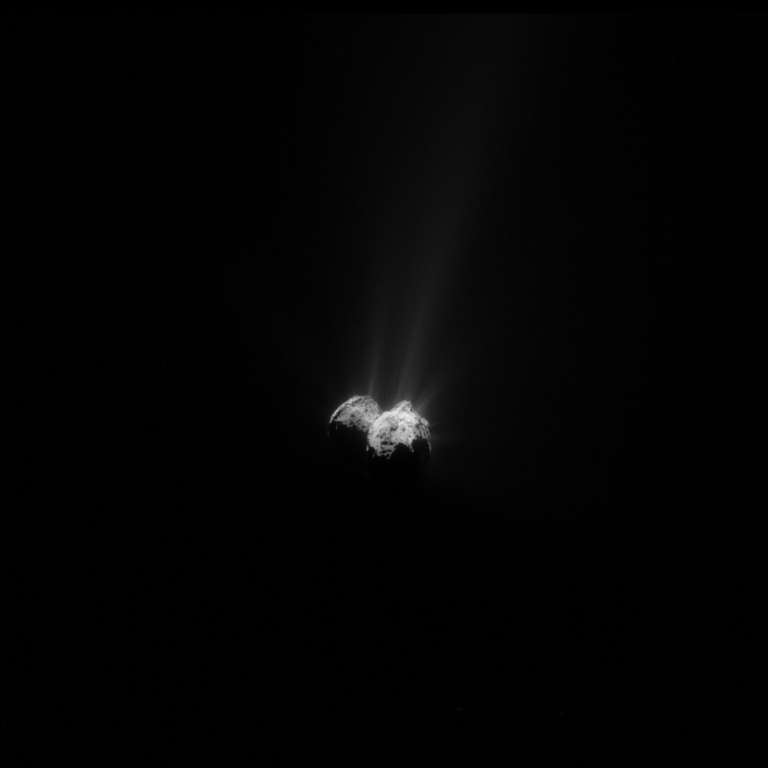Emily Lakdawalla • Jan 29, 2016
What's up in solar system exploration: February 2016 edition
What's going on with our robotic planetary missions? In February I count more than 20 planetary spacecraft exploring six targets beyond Earth or cruising to new destinations. Following are mini-updates on all of the active planetary science missions. As a bonus, I'm now adding a roundup of commercial and human spaceflight launches and other activities to these posts, courtesy of Jason Davis.
As ever, Olaf Frohn's diagram provides a helpful summary of what's going on across the solar system:

Launching from Earth (contributed by Jason Davis)
Here on Earth, it'll be a quiet month for human spaceflight comings and goings. Expedition 46 lasts until March, when one-year ISS crewmembers Scott Kelly and Mikhail Kornienko return to Earth with Sergey Volkov. There aren't any ISS cargo flights scheduled in February, either. Two Russian resupply vehicles, Progress M-29M and Progress MS, will remain docked to the station throughout the month. Orbital ATK's OA-4 Cygnus spacecraft, which arrived in December, is enjoying an extended stay to collect extra trash for destructive reentry, but no firm departure date has been released. On February 3, cosmonauts Sergey Volkov and Yuri Malenchenko will perform a spacewalk to install hardware and science experiments on the station's Russian segment.
In U.S. commercial launcher news, SpaceX may launch the SES-9 communications satellite sometime in February. The company will likely attempt to land the first stage of its Falcon 9 rocket on either a drone ship or back at Cape Canaveral. United Launch Alliance has two missions in February. An Atlas V will launch GPS IIF-12 from Cape Canaveral on Feb. 3, and a Delta IV will blast off with NROL-45 from Vandenberg Air Force Base on Feb. 10.
In international launch news, Japan's ASTRO-H X-ray astronomy satellite takes flight atop an H-IIA on February 12. The European Space Agency's Sentinel-3A earth-observing satellite is expected to launch in the second half of February on a Eurockot Launch Services Rokot vehicle. Additionally, Spaceflight Now reports that Russia, China and India all plan to send navigation satellites into orbit this month.
In Earth's Neighborhood
Up at the Moon, Lunar Reconnaissance Orbiter is still reliably returning data from an orbit that passes very low over the south pole (within around 20 kilometers). According to deputy project scientist Noah Petro, this is a quasi-stable orbit, minimizing fuel consumption; they can last about 7 more years at the current rate. They are looking into ways to conserve fuel to keep the spacecraft going even longer than that. The camera team has been releasing lots of cool anaglyph images recently. Anaglyph images are one benefit of such a long-lived mission; they've achieved enough coverage of the Moon that it's scientifically valuable to spend data bits imaging previously imaged areas a second time from a different angle.
China's Chang'e 3 lander is still returning data to Earth as of earlier this month. No signal from the Yutu rover has been detected this month, so its status is unknown. Also unknown are the status of the Chang'e 2 and Chang'e 5 T1 orbiters, but have been operated for some time to test Chinese deep space communications capability. Still, the last official update that I know of on Chang'e 2's status is from October 30, 2014. Chang'e 3 fans may enjoy the archive of its lander and rover image data that I posted yesterday.
According to an email from scientist Jasper Halekas, the ARTEMIS probes are currently in good health and operating as planned in very stable, highly elliptical orbits; "we should be able to keep them there for years to come." They are focused on heliophysics, working cooperatively with the other THEMIS probes, the Van Allen Probes, and the Magnetospheric Multiscale (MMS) mission, but by virtue of their location in space they study the interaction of the solar wind with the Moon as well.
Having completed the Earth swingby successfully, Hayabusa2 has shifted out of three-axis attitude control into a state called "one-wheel control," in which the spacecraft maintains its attitude using only one reaction wheel plus solar radiation pressure on its solar panels. This mode reduces wear on the reaction wheels, prolonging the life of the mission, and is also just plain cool. JAXA's navigators are now experienced in solar sailing, having used a similar mode on the original Hayabusa out of necessity, and on the IKAROS mission by design.

Inner Solar System
There is nothing at or en route to Mercury, so our first stop in the solar system is Venus. JAXA's Akatsuki is safely in orbit at Venus as of December 7, thank goodness, but it won't be doing science for a while yet. The best source for information continues to be the official Twitter account, which reports (I think) that they have recently switched to regular communications with the high-gain antenna.
Mars
Mars remains the most active spot beyond Earth in the solar system, with two rovers and five orbiters in residence. Both Mars Express and Opportunity recently marked their 12th years of science operations there.
Odyssey is in an exciting new phase of its mission. Odyssey, like Mars Reocnnaissance Orbiter, is in a "sun-synchronous" orbit at Mars; its orbit always crosses the Martian equator at the same local time of day. Until 2008, that time of day was around 5:00 in the afternoon and before dawn. In 2008, they shifted the orbit earlier, to improve the ability of the THEMIS camera to do compositional mapping. Shortly after Curiosity landed, Odyssey began shifting its orbit again, to a morning orbit. Odyssey finally arrived in this new orbit on November 10, and now crosses the equator at 6:45, in the early sunlit morning and after sunset. Deputy project scientist Jeff Plaut tells me that "Odyssey is now in a unique position to observe conditions and phenomena that occur in the Martian mornings, such as the formation and dissipation of clouds, hazes and frosts." So it's going to be a fun year!
Mars Express has had an exciting month, completing an extremely close flyby of Phobos on January 14. The flyby included the opportunity to spot the planned landing site of the Phobos Grunt mission on Phobos anti-Mars hemisphere at higher resolution than previously, but unfortunately due to a persistent memory problem on the aging spacecraft, the images were not saved. The HRSC team continues to release captioned images about once a month at the ESA website. The Mars Webcam has not been on lately; it last returned photos on September 2.
Opportunity has safely passed through winter solstice on January 2, so will spend 2016 enjoying increasing amounts of power as it continues to explore Marathon Valley, on the western rim of Endeavour crater. Actually the power situation is already pretty good, with relatively clean solar panels and relatively clear skies. Read A. J. S. Rayl's report for the latest update on Opportunity's mission to Marathon Valley.
On the other side of Mars, Curiosity is in the middle of its campaign to scoop and sample sand from Namib dune. Unfortunately, the campaign has been beset by glitches that have drawn it out. Most worrisome is a recent anomaly with the CHIMRA mechanism in the robotic arm turret, which is responsible for sieving, portioning, and delivering samples to the analytical instruments. The campaign is on hold as they continue to run diagnostics on CHIMRA, but they are performing lots of remote sensing work as they work through the CHIMRA problem. Before running into the problems with CHIMRA, they took this lovely self-portrait at Namib dune:
Mars Reconnaissance Orbiter is plugging along, routinely posting amazing images and occasionally catching rover hardware on the Martian surface. Late last year the mission had to rewrite the flash memory in one of the two computers to update some data tables that had been built without anticipating the mission's amazing longevity; the tables inform the orbiter where Earth and the Sun are in the sky, crucial information for pointing solar panels and communications antenna. The procedure went well, and this week they are in the process of repeating it for the other computer; I'm told they'll resume full science and relay operations this weekend.
I asked principal investigator Bruce Jakosky for an update on the newest orbiter at Mars, MAVEN. They are now in their first mission extension, a brief one that will sync them up, come October, with the process under which all NASA extended missions are reviewed. That will also take them through one complete Mars year of atmospheric observations. This extension will include two "deep-dip" campaigns (compared to four in the prime mission). Beyond their basic observations, Bruce said, "we're planning to test and possibly implement new observations that would substantially augment aspects of our science, based on the results obtained to date."
Beyond Mars
Recent science results from Rosetta include the confirmation that bright spots on the surface of comet Churyumov-Gerasimenko are definitely water ice. ESA's Archive Image Browser now includes OSIRIS images through September 16, 2014, and they have recently added several new albums of NavCam images through "Comet Escort 3," through October 20, 2015. Those NavCam images take you right through perihelion, when the comet was putting on a spectacular show. Don't forget to check out the OSIRIS Image of the Day archive (which averages an image every other day). Sadly, it looks like Rosetta has heard the last from Philae, although there has not yet been an official statement that the Philae mission is over. Here's one of the more recent Navcam releases, taken during the "far excursion" phase:

Dawn is now orbiting Ceres at the lowest altitude it'll ever achieve: an average 385 kilometers. At this altitude it can achieve image resolutions of about 35 meters per pixel, but imaging is not the primary goal of this orbit. Rather, the lowest orbit enables the GRaND instrument to do its best detection of the composition of the surface of Ceres, and also increases the precision of Dawn's gravity maps. The longer that Dawn remains in orbit, the better its composition and gravity maps will be. Marc Rayman explains both of these in his latest Dawn Journal. But Dawn will still be imaging quite a lot as interesting targets wander through its field of view; check the Photojournal for those images. Today, the mission released this lovely animation made from data captured during the high-altitude mapping orbit.
Juno is now less than six months away from Jupiter. As of this month, it's gone farther than any previous solar-powered spacecraft. Amateur astronomers continue to pour images into the JunoCam image database to help the team plan future imaging.
Cassini is now flying up and out of the ring plane, and its next flyby of Titan on February 1 will increase its orbit inclination from 2.4 to 16 degrees. We'll be treated to dramatic views of open rings the likes of which we haven't seen since early last year. The orbit inclination and openness of the rings is going to increase all year long, up to nearly 64 degrees by the time Cassini begins its "F-ring orbit" phase on November 29.
New Horizons completed "Departure Phase 3" on January 15, a period when it was using fields and particles instruments to monitor Pluto's tail. The next target they plan to observe is 1994 JR1, in April. January 19 marked the 10th anniversary since their launch; on the same day, they passed the 9-astronomical-unit marker in terms of range to the extended-mission target, 2015 MU69. New Horizons is also just two weeks away from completing the downlink of all its highest-priority, "Group 1" data. As far as I understand it, that starts a clock for the first public release of its science data in April. Unfortunately, although the mission is getting all precious 70-meter downlink time it has asked for, various issues at different Deep Space Network stations have resulted in less data being downlinked than anticipated. No data is being lost -- they just need to retransmit it -- but it's possible that the mission will not have all its data on the ground by the end of the fiscal year, as originally hoped. It's looking more like the end of the calendar year 2016 at the moment. On top of all of this, the team is busily planning the MU69 flyby; the science team is now leaning toward a flyby at a distance of 2000 to 3000 kilometers, with closest approach on the lit side of the target object. They continue to release captioned images every Thursday, including this map of water ice across Pluto's surface.
Which brings us to the last, distant travelers, the Voyagers. This month was the 30th anniversary of the Voyager 2 flyby of Uranus. They're still traveling, roughly three times farther from the Sun than New Horizons is, well beyond the outer edge of the Kuiper belt. Voyager 1 is now 20 billion kilometers from the Sun, and almost 134 AU. It takes more than 37 hours for signals to travel from Earth to Voyager 1 and back. Voyager 2 is closer, but still unimaginably far away. And through their entire journey, they've had the same project scientist, Ed Stone, whose 80th birthday was celebrated at JPL this week.
Tune in next month for an update on our intrepid planetary explorers!
Let’s Go Beyond The Horizon
Every success in space exploration is the result of the community of space enthusiasts, like you, who believe it is important. You can help usher in the next great era of space exploration with your gift today.
Donate Today

 Explore Worlds
Explore Worlds Find Life
Find Life Defend Earth
Defend Earth

